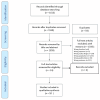Prevalence of Preterm Birth in Saudi Arabia: A Systematic Review and Meta-Analysis
- PMID: 39735059
- PMCID: PMC11672225
- DOI: 10.7759/cureus.74562
Prevalence of Preterm Birth in Saudi Arabia: A Systematic Review and Meta-Analysis
Abstract
Preterm birth, defined as delivery before 37 weeks of gestation, is a significant contributor to neonatal morbidity and mortality worldwide. Understanding the prevalence of preterm birth is critical to improving neonatal care, informing public health strategies, and supporting health care planning. The objective of this study was to explore the problem of preterm birth in Saudi Arabia by estimating the prevalence of preterm birth over a defined period of time. CINAHL, Cochrane Pregnancy and Childbirth Database, Embase, and Medline were searched, limiting the search to the human Saudi population, with no date or language restriction. Titles, abstracts, and full texts were screened to determine eligibility for inclusion. Included studies were assessed for risk of bias utilizing the Let Evidence Guide Every New Decision (LEGEND) tool. Then, data were extracted in a customized data collection form. Among the 14 full texts reviewed, 10 studies met the eligibility criteria and were included in the final review, with a total of 50,514 participants for singletons and 336 sets of twins or/and high-order gestation in different regions of Saudi Arabia. Six studies have been entered into the meta-analysis and resulted in a pooled prevalence of preterm birth of 7.89 per 100 live births (95% confidence interval: 6.94 to 8.97). For multiple pregnancies, the average prevalence of preterm birth was 91.3 per 100 live births (95% confidence interval: 88.3 to 94.3). The overall preterm birth rate in Saudi Arabia can be utilized in national health planning and public health policy development. By knowing the prevalence of preterm birth, healthcare practitioners and policymakers can effectively plan for capacity building and healthcare services to provide efficient and proactive care for preterm infants, ultimately improving patient outcomes by reducing neonatal morbidity and mortality.
Keywords: maternal; pregnancy; premature birth; preterm; saudi arabia.
Copyright © 2024, Almaghaslah et al.
Conflict of interest statement
Conflicts of interest: In compliance with the ICMJE uniform disclosure form, all authors declare the following: Payment/services info: All authors have declared that no financial support was received from any organization for the submitted work. Financial relationships: All authors have declared that they have no financial relationships at present or within the previous three years with any organizations that might have an interest in the submitted work. Other relationships: All authors have declared that there are no other relationships or activities that could appear to have influenced the submitted work.
Figures



References
-
- WHO: recommended definitions, terminology and format for statistical tables related to the perinatal period and use of a new certificate for cause of perinatal deaths. Dbstet A. Acta Obstet Gynecol Scand. 1977;56:247–253. - PubMed
-
- Prevention of spontaneous preterm delivery - an update on where we are today. Ahmed B, Abushama M, Konje JC. J Matern Fetal Neonatal Med. 2023;36:2183756. - PubMed
Publication types
LinkOut - more resources
Full Text Sources
Miscellaneous
